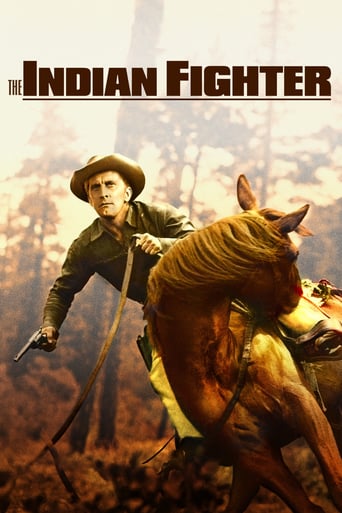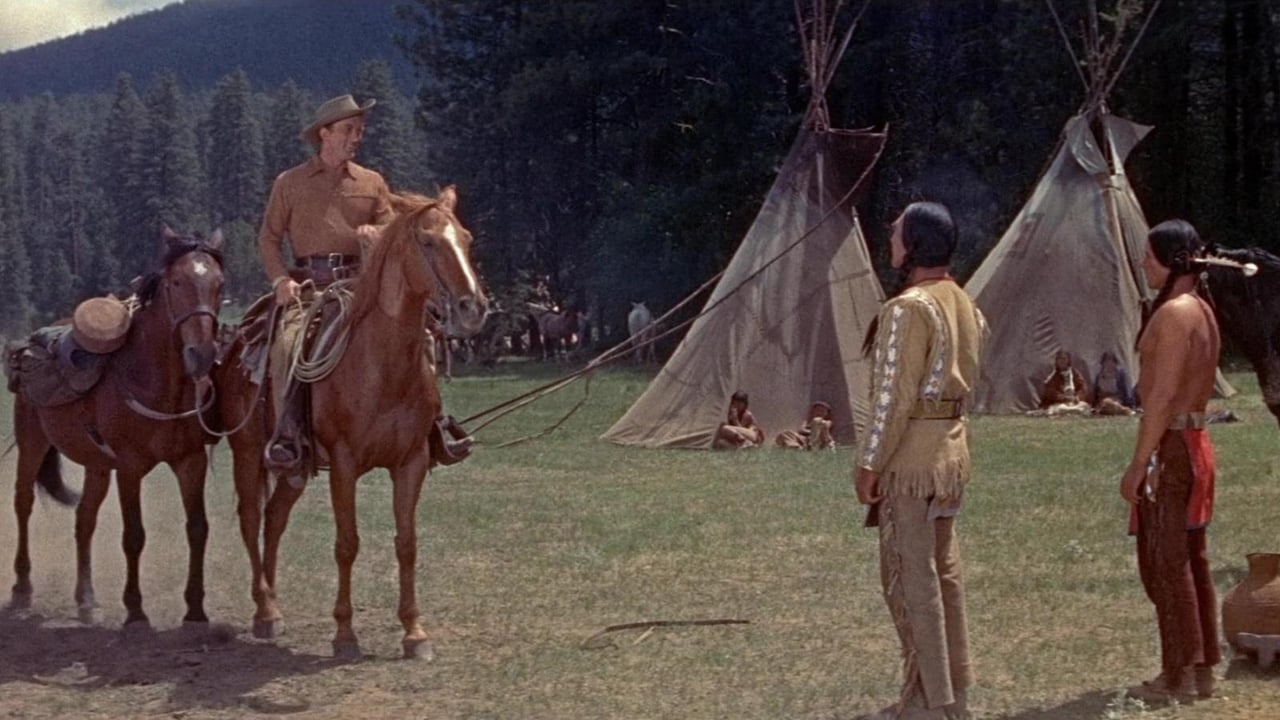LeonLouisRicci
This is an Odd Combination of Light Hearted Playfulness Punctuated with Plenty of Sex and Violence. Ramped Up Sex and Violence for the 1950's. it is Also Elevated by some Themes Only Found in the Best of the Genre until the Code was Eliminated.It has Social Concerns about the Environment and Treatment of the Indians. The Violence is Brutal at Times with some Very Bloody and Edgy Portrayals of Scalping, Knifing, and has One or Two Scenes that are Remarkable in the Aftermath of some Sioux Arrows.There is an Interracial Romance, Semi-Nudity, Rape, and an Attack on the Fort that shows the Intelligence and Resourcefulness of the Indians. There is also a Subplot about the New Invention of Photography and the Film's Cinematography is CinemaScope Sensuous. Some Drawbacks Include Weak White Bad Guys, another 1950 Inclination to have an Obligatory Whiny Kid, and a Intrusive Score from Frank Waxman. Overall, Above Average, Cutting Edge, and Entertaining. Recommended for Western Buffs and this would Fit in Nicely for Fans and Followers of Anthony Mann, Budd Boetticher, and Sam Fuller.
MartinHafer
With a title like THE Indian FIGHTER, you'd think that this was the standard "let's kill all the Indians" type movie so typical in the 1940s and 50s. However, like some of the better cowboy and Indian films of the era (such as the great FORT APACHE and the not so great CHEYENNE), the reason for the Indians hating the Whites is explained--they are not just unreasoning savages or idiots, but people justifiably angry at their mistreatment by the invading Whites. Because of this, I appreciated the film and was also happy that it also wasn't like some of the newer breed of films that paint the Indians and completely noble and the Whites as the epitome of evil! It did seem well balanced AND featured mostly Indians in Indian parts (though, oddly, they chose an Italian lady to play the female leading Indian!).The rest of the film, while entertaining and having the usual great performance by Kirk Douglas, also is very simplistic and poorly thought out at times. For example, the motivation for why Douglas saved Walter Mathau's sorry butt at the beginning of the film is unclear. It defied common sense not to just let the Indians kill Mathau. Plus, at the end of the film, Douglas' confrontation with Douglas and Lon Chaney, Jr. was a long time coming but was resolved awfully quickly--making it seem very anti-climactic. Still, overall it does stand out from the HUGE number of look alike Westerns and it is worth your time.
ragosaal
I remember having enjoyed very much this film as a kid back in the 50's, but not when I saw it again a couple of years ago. The story is not better or worst than that of many other westerns -a scout leads a wagon train through hostile Indian territory- but Andre de Toth's direction is weak and completely standard; these are things you don't notice in films as a kid when you're more interested in cowboys and Indians fights and action scenes. In my opinion, De Toth was just an average director that will probably be remembered for his earlier work in "House of Wax" (1953) when aided by an interesting plot and an excellent Vincent Price he achieved a little classic in the horror genre; but he never reached the mark later.As for "The Indian Fighter", you can rescue Kirk Douglas undeniable strong screen presence, one of Walter Mattau's early roles as a villain and the sensual Italian actress Elsa Martinelli as an Indian squaw that gets mixed up with Douglas.But there's not much more in this average and common film, only for fans of the genre or good old Kirk (in his late thirties back then).Just for the record: in Argentina "The Indian Fighter" was renamed as "A un Paso de la Muerte" (something like "Just One Step Away from Death").
FilmFlaneur
At the heart of De Toth's oeuvre lies an interesting contradiction. He has an abiding interest in suspense, action, and the wellspring of violent events (a fact underlined by the number of thrillers, frontier yarns and dramas he helmed during his career), but, as a director, characteristically disassociates himself from their process. This 'distancing' effect has been noted by a number of viewers, creating some critical debate about De Toth's engagement with his material. In my view his detachment is not to be confused with aloofness - an interesting comparison can be made with Stanley Kubrick's alleged 'coldness' - but is rather De Toth's way of resolving what really 'matters'. It is this intelligence, revealing itself sharply in his best films, that makes him such a worthwhile study. Along with De Toth's assured debut 'Ramrod' (1947) and the austere 'Day of the Outlaw' (1959), 'The Indian Fighter' is probably the finest of his Western films, revealing a characteristic response to the demands of the genre. In 'Ramrod' the moral questing springs from a noirish plot that is unsettled and full of tension. In 'Day of the Outlaw' issues are resolved more formally, played out against the stark landscape of Winter. In 'The Indian Fighter', De Toth's concerns manifest themselves in his most lyrical and sensuous work. He thereby creates a film which, in emphasis, is in direct contrast to most other 50's Westerns.This is ostensibly a tale of a famous frontiersman Johnny Hawks (played with usual lusty gusto by Kirk Douglas), back from the wars. Ultimately he has to redeem his reputation, discovering balance within the indigenous people he has previously warred against. Gold has been discovered on Indian land, and the bad guys (a marvellous performance by Walter Matthau, ably supported by Lon Chaney, Jnr) are out to kill and cheat to secure the riches. This, and the related fear of a tribal uprising, provide the main action point of the film. As the Indian fighter of the title, ironically the first thing we notice about Hawks is his reticence. In fact he hardly fights at all - only when he is obliged, or when called upon to at the climax of the film. For him, combat is not a prerequisite, although he is not slow to react when needs be. A comparison with the bitterness of Ethan Edwards, say, in Ford's 'The Searchers' is revealing. Edwards loathes the Commanches, with a bitterness entirely absence from De Toth's hero. As Hawks' opponents observe, he is more of an Indian lover than fighter. And, of course, in the most obvious way, they are right. Almost more important to the hero than his professional reputation is his preoccupation with the Indian maid Onhati. His single-minded pursuit, and later dalliance, with her initiates the main crisis of the film, as he leaves the wagon train to be by her side, after taking it 'two days out of my way and half way up a mountain'.This is a film full of sensuality, placed in contrast to 'duty', the calling of action. We are constantly reminded of the cool pools, green foliage, closeness of the earth, just as much as of the teachery and turmoil of the frontier. Franz Waxman's score is lyrical and evocative, frequently idyllic. The glorious cinematography gives nature's perpetual garden a pantheistic gloss, sometimes intense, and always resplendent. Just as the main film captures these images, so in mimicry does Briggs, a supposed protégé of civil war photographer Matthew Brady, who frequently accompanies Hawks. He is eager to capture the grandeur around him. His camera is as significant to us as it is to Hawks, who makes a point of rescuing it at one point (during the battle at the fort). An important minor character, Briggs emphasises the appreciation of the sublime and beautiful that the film invites. A couple of times De Toth pauses the action (once at the fort and then at the wagon train), to pan his camera for long seconds along sets and people, recording their place in the Oregon landscape. Like Briggs he wants to admire, and record.A circular film, 'The Indian Fighter' begins with Hawks gazing at Onhati bathing naked in a pool. It ends with him joining her in the water, forming a happy couple. The whole world of action is thus enclosed by their bonding, their sensual preoccupation usurping the violent demands of Indian-white conflict. The scenes between the two lovers caused a murmur at the time. Considered 'risque' for the conservative 50's Western, De Toth simply inserted them, and their sexual self-absorption, as entirely fitting his plan of things. What is more eyebrow-raising today is how he allowed the encounters between two lovers to backstage the expected intrigues of masculine action, and actually assume greater significance, reversing regular audience expectations. This stress, an essentially feminine one. is completely uncharacteristic of the Western at this time. Add to that a sympathetic view of Indians and nature conservation (the Indian Chief's environmental concerns are a main reason for his refusing to exploit the land with mining) and you have an excellent film - a career highlight of this greatly underrated director.


 AD
AD




